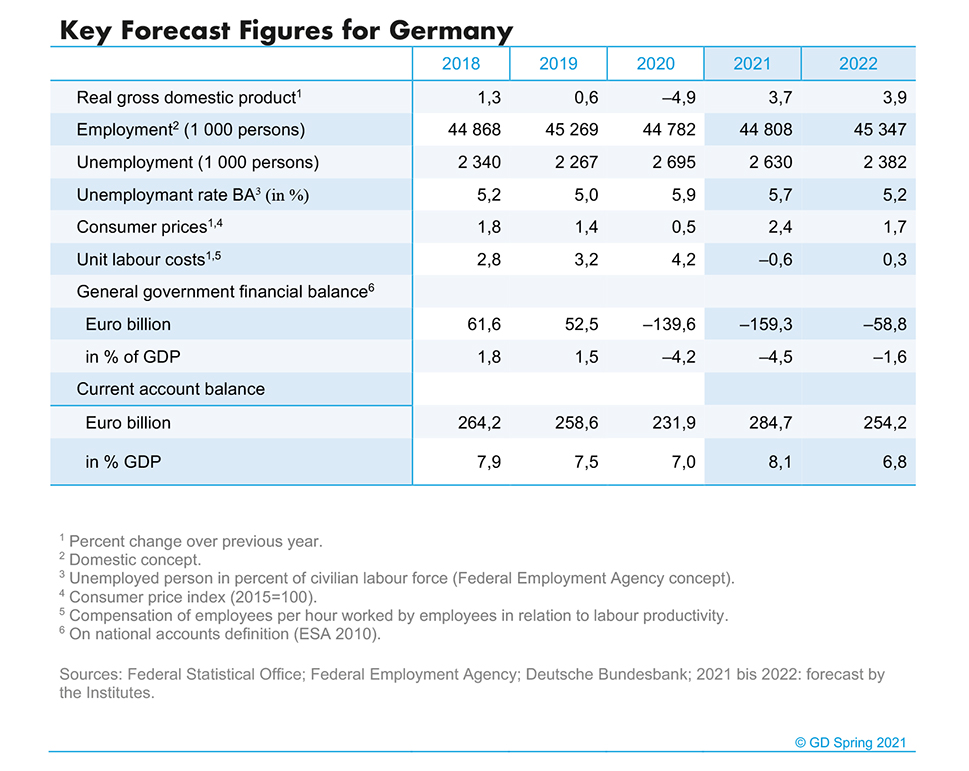Joint Economic Forecast Spring 2021: Pandemic delays upswing – Demography slows growth
“Economic output is likely to have dropped by 1.8 percent in the first quarter due to the continuing shutdown,” said Torsten Schmidt, Chief Economist at RWI – Leibniz Institute for Economic Research. The new wave of infections and the associated containment measures lead to the downward revision of the forecast for 2021 by 1 percentage point compared to the fall forecast 2020.
In their forecast, the institutes assume that the current shutdown will continue for the time being and that the most recent easing measures will be largely reversed. Further easing is not expected until the middle of the second quarter, with restrictions probably lifted by the end of the third quarter. “We expect a vigorous expansion of economic activities as the measures are gradually lifted over the course of the six months through the summer, especially in the services sector that was particularly affected by the pandemic,” Schmidt added.
Employment is also likely to gain momentum in view of the expected easing of restrictions. On average, employment is expected to rise by 26,000 over 2021. The rise is estimated at 539,000 over the coming year, with pre-crisis levels being reached in the first half-year. Unemployment levels are also expected to drop more sharply as the infection control measures are gradually lifted.
Public budgets are expected to show a deficit of €159 billion in 2021, slightly higher than in the previous year. Tax revenues are already rising again due to the economic situation. However, spending on vaccinations and tests is causing social benefits in kind to rise sharply. Moreover, government investment is likely to continue expanding, especially due to the funds available in investment programmes. In relation to GDP, the general government budget deficit is expected to remain roughly the same at 4.5 percent in 2021 and to drop significantly to 1.6 percent in 2022.
The corona crisis has also had a clear impact on the labor market. Despite massively falling back on short-time working schemes, an estimated 820,000 jobs were lost by mid-year. Since then, the number of people in employment has risen again slightly, but the pre-crisis level will not be reached until mid-2022. The unemployment rate is expected to rise to 5.9 percent this year and next year, and to fall slightly to 5.5 percent in 2022.
The coronavirus pandemic is leaving its mark on production potential as well. Current forecasts suggest that between 2020 and 2024, it is likely to be on average around 1.1 percent below the levels originally estimated prior to the Corona crisis. In addition, there are already signs that Germany is facing a far-reaching demographic transition in the years ahead. The total workforce will shrink as the baby boomers reach retirement age, accompanied by a sharp rise in the proportion of older people. This will have serious consequences for growth potential: projections indicate that the rate of growth potential is expected to decline by around one percentage point by 2030.
The further development of the pandemic remains the most significant downside risk to the outlook. Bottlenecks and delays may still occur in the delivery of vaccines and tests. Moreover, the emergence of new virus mutations might erode the effectiveness of vaccines, potentially halting the opening process and once again causing setbacks in the economic recovery.

The Joint Economic Forecast was prepared by the German Institute for Economic Research (DIW Berlin), the ifo Institute (Munich), the Kiel Institute for the World Economy (IfW Kiel), the Halle Institute for Economic Research (IWH), and RWI (Essen).
Full-length version of the report (in German)
Key Forecast Figures for Germany
Pandemic delays upswing – Demography slows growth, Spring 2021. Essen 2021.
The German full-length version of the report is available at www.gemeinschaftsdiagnose.de/category/gutachten/.
About the Joint Economic Forecast
The Joint Economic Forecast is published twice a year on behalf of the German Federal Ministry for Economic Affairs and Energy. The following institutes participated in the spring report 2021:
- German Institute for Economic Research (DIW Berlin)
- ifo Institute - Leibniz Institute for Economic Research at the University of Munich in cooperation with the Swiss Institute for Business Cycle Research (KOF) at ETH Zurich
- Kiel Institute for the World Economy (IfW Kiel)
- Halle Institute for Economic Research (IWH) – Member of the Leibniz Association
- RWI – Leibniz Institute for Economic Research in cooperation with the Institute for Advanced Studies Vienna
Scientific contacts
Dr. Claus Michelsen
German Institute for Economic Research (DIW Berlin)
Tel +49 30 89789 458
CMichelsen@diw.de
Professor Dr. Timo Wollmershäuser
ifo Institute – Leibniz-Institute for Economic Research at the University of Munich
Tel +49 89 9224 1406
Wollmershaeuser@ifo.de
Professor Dr. Stefan Kooths
Kiel Institute for the World Economy (IfW)
Tel +49 341 8814 579 or +49 30 2067 9664
Stefan.Kooths@ifw-kiel.de
Professor Dr. Oliver Holtemöller
Halle Institute for Economic Research (IWH) – Member of the Leibniz Association
Tel +49 345 7753 800
Oliver.Holtemoeller@iwh-halle.de
Professor Dr. Torsten Schmidt
RWI – Leibniz Institute for Economic Research
Tel +49 201 8149 287
Torsten.Schmidt@rwi-essen.de